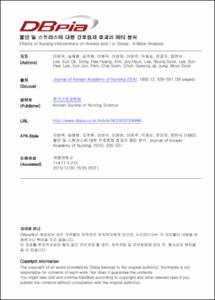불안 및 스트레스에 대한 간호중재 효과의 메타 분석
- Keimyung Author(s)
- Lee, Byoung Sook; Lee, Eun Ju
- Department
- Dept. of Nursing (간호학)
- Journal Title
- 대한간호학회지
- Issued Date
- 1992
- Volume
- 22
- Issue
- 4
- Abstract
- The purpose of this study was to identify the commonalities of various nursing interventions and effective intervention methods in each intervention through analysis and synthesis of many accumulated research papers. The study analyzed the effects of various nursing interventions on anxiety and /or stress. For this purpose, 64 experimental studies with randomized or nonequivalent control group pre-test-posttest design were selected from journals of medical and nursing schools, the Korean Nurse, the Korean Nurses' Academic Society Journal, the Central Journal of Medicine, the New Medical Journal, the Nurse Monthly, and from theses and dissertations conducted from 1970 to 1991. The selected studies wrer classified according to three characteristics : 1) the research sample, 2) types and methods of nursing interventions, and 3) stat¬istical tests. The following analysis was done ; 1) Confirmation of the accuracy of data drawn from each study by paired review, 2) Estimation of the
homogenity of pre-test scores of the dependent vari¬able between control and experimental groups warranted the effect size of post-scores, 3) If the homogenity of pre-test scores did not warrant, the change scores from pre-test to post-test were used to estimate the effect size, 4) Use of the effect size of each study among homogenious studies was tested for each intervention method, such as relax¬ation, information, and touch and /or support. Finally, for the studies not showing homogenity, an ANOVA test was used to identify patterns for each intervention.
Some findings are summarized as follow :
The effect sizes for relaxation and information were greater than those for touch and /or support¬ive technique.
Studies using random assignment had greater effect sizes than nonrandomized sample studies using the same intervention.
For healthy people, group education was more ef¬fective than individual teaching. However, for patients, relaxation and touch and/or supportive techniques given on individual basis were more ef-fective than when given in a group situation.
Measuring anxiety and stress by biological indicators was less effective than by self-report.
Budzynski's relaxation method was the most ef¬fective.
The more frequently the techniques applied, the larger the effect size.
- Alternative Title
- Effects of Nursing Interventions on Anxiety and / or Stress : A Meta-Analysis
- Publisher
- College of Nursing
- Citation
- 이은옥 et al. (1992). 불안 및 스트레스에 대한 간호중재 효과의 메타 분석. 대한간호학회지, 22(4), 526–551.
- Type
- Article
- ISSN
- 2005-3673
- Appears in Collections:
- 2. College of Nursing (간호대학) > Dept. of Nursing (간호학)
- 파일 목록
-
-
Download
 oak-bbb-00069.pdf
기타 데이터 / 2.23 MB / Adobe PDF
oak-bbb-00069.pdf
기타 데이터 / 2.23 MB / Adobe PDF
-
Items in Repository are protected by copyright, with all rights reserved, unless otherwise indicated.